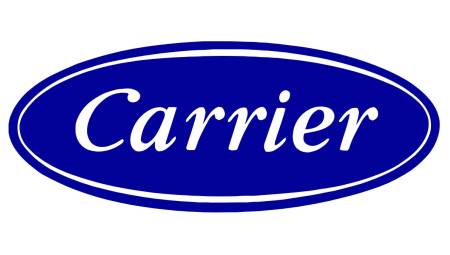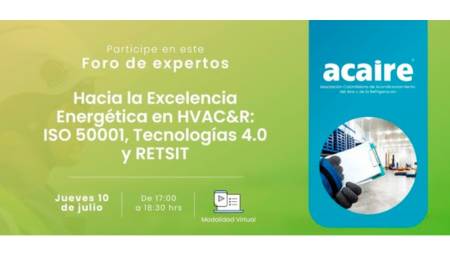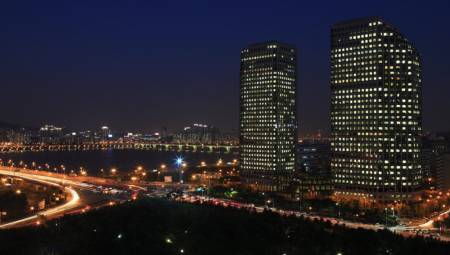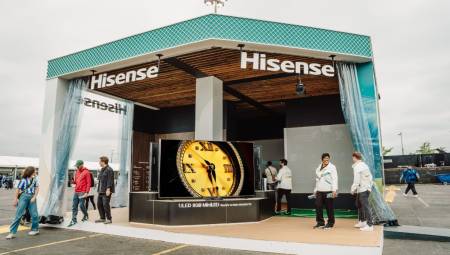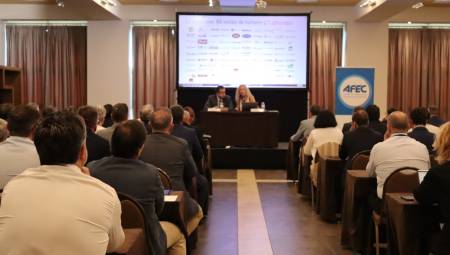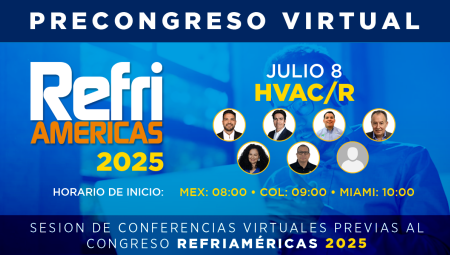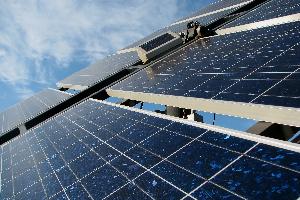 The issue of solar HVACR is gaining more and more strength in Latin America, given the introduction and use of renewable energies in the industrial and residential sector for several years.
The issue of solar HVACR is gaining more and more strength in Latin America, given the introduction and use of renewable energies in the industrial and residential sector for several years.
By: Santiago Jaramillo H.
Regarding the recent achievements made by Scientists from the Center for Energy Research (CIE) of the National Autonomous University of Mexico (UNAM), with the development of an air conditioning system powered by solar energy, suitable for the climatological circumstances of insolation, temperatures and humidity that predominate in most of the Mexican territory, and that it is still in the development stage, we wanted to invite some experts in the field to tell us how viable an initiative of this type is in the region.
For César Alejandro Isaza Roldán, a research professor at the Energy and Thermodynamics Group of the Institute of Energy, Materials and Environment of the School of Engineering of the Pontifical Bolivarian University of Medellín, Colombia, the introduction of new solar HVACR technologies requires structured plans that guarantee their adaptation to the conditions of the region.
"In Latin America there have been isolated experiences in the use of solar HVACR systems, especially in Mexico, where these facilities did not last over time and additionally left a bad reputation on the part of users, causing the advance of the market to have stagnated," says Isaza.
The professor also recognizes that most solar HVACR systems installed in Europe operate under solar irradiance conditions typically greater than 5 kWh/m2 day, which occur in most Latin countries. "These technologies are relatively simple in their conception, and in Latin America there is the necessary technology to build these equipment, without depending heavily on industrialized countries, which can represent an opportunity for technological development for the region," he says.
It should be noted that solar HVACR systems are designed for low powers (less than 30 TR or 100 kW of cooling capacity), since one of the most expensive components (50% of the total value) is the solar collection system that considerably limits the size of the equipment. For this reason, most of the installations in Europe are seasonal and operate both with solar energy and with conventional sources (natural gas, steam, etc.), seeking to reduce investment and operating costs.
After the previous acote, the academic ponders that "the viability of solar HVACR systems is linked to the development of solar collector technology and cost reduction, which is being evidenced by the recent increase in the supply of solar collection equipment from China, at very competitive prices and with vacuum tube technologies, suitable for reaching the temperatures required in these systems."
Isaza also stresses that one of the main obstacles to the development of solar HVACR systems in our region is the absence of promotion and dissemination programs, such as those that exist in Europe, that finance demonstration facilities, promote technological development in companies and universities, are articulated with tax incentives such as clean and efficient technologies, and allow end users to gain confidence in a new HVAC alternative.
In this same sense are the opinions of the Brazilian Rodnei Peres, belonging to the Department of Foreign Trade of Full Gauge Controls, who emphasizes that "for there to be greater development it is necessary that governments invest and encourage the use of this type of energy. In Brazil, for example, the creation of laws mandating the use of solar heating in new constructions made this market grow in large proportions." It also highlights that another element that contributed to this positive scenario was "the growing use of solar collectors in housing complex projects made by various state governments."
The above, as recognized by our guest from Full Gauge Controls, makes industries invest more and more in development and technology, manufacturing quality products that last longer, reaching European levels.
"In Brazil, especially a lot has been invested in solutions for people with more precarious economic conditions, with the same quality, all on account of the laws created. It is a way to make it possible for many people who do not have access to electricity to have light. For me, it is a matter of time for Latin America to surpass Europe in the manufacture and consumption of these systems," says Peres.
Advantages over traditional systems
According to the representative of the company Full Gauge Controls, "it is enough to compare the solar energy system with that of an electric shower (used in most houses in Brazil). When mentioning solar energy we are talking about a free and renewable resource, taking into account that a water heater uses a resistance of 5,500 watts when used for two hours a day, we will have an expense of more or less US $ 40 per month (these values can change from region to region and from country to country). An installation with solar energy is paid in less than a year, without saying that the maintenance is reduced or non-existent. That (part of savings) without talking about the environmental issue, an increasingly important issue around the world."
On the other hand, and as explained by the researcher César Alejandro Isaza Roldán, the installation of a solar HVACR system can contribute in four basic points:
* Replace the demand for conventional energy sources by using solar thermal energy.
* Reduce greenhouse gas emissions.
* Support the stability of electricity grids, reducing both electricity consumption and peak demand.
* Optimize the use of solar thermal systems by employing solar heat for combined assistance in space heating, cooling and water heating.
Regarding the duration of the equipment, performance and noise levels reached by HVACR systems compared to traditional systems, and the possible advantages and / or disadvantages, Rodnei Peres states that "I do not see a disadvantage, because currently the pumps are increasingly silent. With regard to the durability of the systems, all material of the installation of this system is manufactured to last. We are talking about a useful life of 15 to 20 years with minimal maintenance. In the past decade we could say that in cold regions the system did not yield enough to amortize the value invested. But today, with ambient temperatures below - 20 degrees Celsius, we are heating water to temperatures above 80ºC. There was also the problem of rain and hail, but currently the quality of the material used is very large, making the durability increasing, "he says.
Meanwhile, the representative of the Pontifical Bolivarian University maintains that worldwide about 60% of solar HVACR equipment operates under the principle of the absorption cooling cycle, so it is worth highlighting the characteristics of these with respect to traditional systems.
"Absorption equipment has virtually no moving parts, except for a pair of solution pumps and, in some special cases, a vacuum pump that operates sporadically. For this reason, the duration of this equipment, under normal conditions of operation and maintenance, can have a much longer service life than HVACR vapor compression systems, reaching even 30 years, "says Isaza Roldán.
It also warns that "the efficiency of solar-powered absorption cooling cycles basically depends on the efficiency of solar collectors and the performance of the absorption cooling system used. Generally speaking, solar cooling has low efficiencies, between 0.5 and 0.7 for the one-effect absorption cooling cycle and 0.5 to 0.6 for the solar collector, resulting in an overall efficiency between 0.25 and 0.42. maximum. The performance of the system will influence the return on investment, since the cost of operation is practically zero compared to a conventional system."
Among other advantages, concludes the Colombian professor, solar HVACR systems have much lower noise levels than conventional systems, use environmentally friendly refrigerants that do not threaten the ozone layer and do not contribute to global warming; they are a safe option with high reliability, can use other backup or residual power sources and require tight spaces compared to conventional systems.
In short, this type of systems are a good alternative in times like the current ones in which non-renewable resources represent large sums of money annually for the industry, so in the nearest future than many think, they will cease to be a simple option to become a necessity.
BOX
Research and development
In terms of research and development, according to César Alejandro Isaza, the trend towards the use of solar energy in air conditioning systems requires testing or developing new and innovative equipment for capturing solar radiation inexpensive and efficient; thermodynamic cycles specially adapted to operate in the conditions of the region, refrigerants or mixtures of refrigerants and absorbents with special additives that allow to achieve high yields in the operation of the cycle.
Likewise, evaluate, simulate and improve the specific processes of the cycle, such as the absorption process itself; in addition to control systems that allow the optimal integration of solar collection systems, energy storage, cold production, heat rejection, cold storage and the auxiliary or backup subsystem.
Lithium bromide (LiBr) technology is still best suited for solar-powered small-power systems. However, this option is closely related to the technology of solar collectors and the appropriate temperatures for the generation of the refrigerant.
The objectives pursued with the new developments have to do on the one hand with the reduction of the required thermal level of the activation energy, to be operated with flat solar capture systems or waste heats; in this case the refrigeration cycle by medium-effect absorption is an alternative that is currently being investigated. On the other hand, the dissipation of heat through air instead of requiring water, has encouraged numerous studies to increase the solubility limit of aqueous Solutions of LiBr by adding other salts or additives, since any kind of improvement in solubility could be enough to extend the applicability of water-cooled LiBr/Water absorption machines and to develop new air-cooled equipment.





